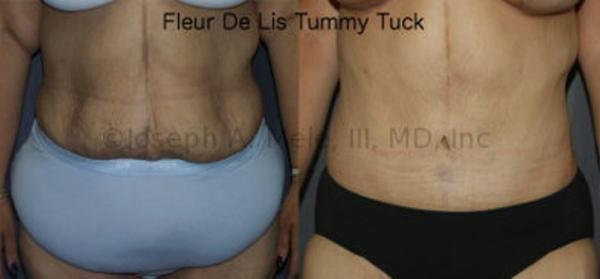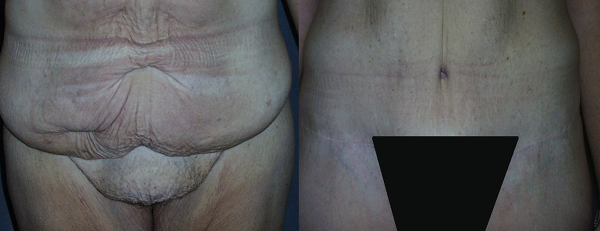The Tummy Tuck remains one of the most popular Cosmetic Plastic Surgery procedures. Also called Abdominoplasty, the procedure tightens the abdominal wall and is especially useful after pregnancy or weight loss.
Tummy Tucks After Other Abdominal Surgery
The question of how preexisting abdominal surgery effects Tummy Tuck planning, execution and recovery often arrises. While most the time an Abdominoplasty can be safely performed, there are some incisions that make the procedure dangerous. Today, we will talk about how scar location may change your Tummy Tightening Procedure.
Where Is The Tummy Tuck Scar?

The above Tummy Tuck before and after pictures show where the skin is removed.
To understand how previous surgery effects Abdominoplasty, it is important to know the location of the removed skin and the circulation that supplies the remaining skin. As the Tummy Tuck Before and After Pictures above show, the lower abdominal skin is excised to remove the excess from the lower belly, to lift the skin above the pubic region (the FUPA) and to leave a scar which is low enough that it hides below the belt-line. The circulation that keeps the remaining skin alive travels in the superficial circulation of the skin that is located above and lateral (toward the sides). It’s the circulatory pattern of the remaining skin that really determines which, if any, of the surgeries performed prior to the Tummy Tuck are likely to cause problems.
Common Surgeries That Do Not Effect Abdominoplasty
In general, any surgery which leaves a scar within the excised skin is safe. This includes c-section, hernia and low appendectomy scars. Surgeries which leave small scars, such as laparoscopic surgery are safe.
Longer scars in the midline are also safe. Since the blood supply comes from each side independently, an incision that runs up and down the middle is unlikely to cause wound healing problems. Below is an extreme example.
The Fleur-de-Lis Tummy Tuck

The Fleur-de-Lis Tummy Tuck is an unusual Tummy Tuck that includes not only the usual low abdominal skin resection, but also removes skin from the middle of the abdominal wall to tighten side to side.
The Fleur-de-Lis Tummy Tuck is used in cases of extreme weight loss, when the upper abdominal skin is loose from side-to-side. In the example above, my patient had a pre-existing midline scar running from the rib cage to the pubic region. Since the scar is in the middle, it is not cutting across the blood supply and is removed with the excess skin.
The previous scar was excised with the loose upper abdominal skin as evidenced by the removal of the excess skin in her underwear, as well as the excess skin located above the underwear. Her clothes fit much better after her surgery, and her mobility is improved thanks to the loss of the excess abdominal skin. The muscle, too, was tightened to further improve the cosmetic results and to provide better muscular support for her abdominal wall.
No More FUPAs

The FUPA (fat upper pubic area) is the excess fullness located above the pubic region and below the excess belly skin. If not addressed at the time of a Tummy Tuck, this excess skin can be a continued source of annoyance and embarrassment.
The FUPA (fat upper pubic area) can be seen in the Abdominoplasty Before and After Photos above. It is the separate skin fold / bulge seen below the redundant abdominal wall skin and above the pubic region. If a standard Tummy Tuck is performed, the FUPA remains a source of annoyance and embarrassment. These pictures were originally shown on my TV show, Body Beautiful. The before picture did not require censorship, because the FUPA covered the private area.The after picture, on the other hand, had to be covered. The scar from the Tummy Tuck can be seen extending laterally from the sides of the blacked out pubic region.
Common Surgeries That Complicate Abdominoplasty
The most common surgeries that can negatively impact the healing after a Tummy Tuck include the traditional “open” cholecystectomy (gall bladder) and pancreatic or any other upper abdominal surgery performed through a “chevron” incision.
The traditional cholecystectomy scar runs diagonally across the right upper quadrant of the abdomen, parallel to the lower edge of the rib cage. This incision cuts the blood vessels supplying the skin below the scar and can lead to problems with circulation to the sin between the scar and the Abdominoplasty scar. Problems can range from slight redness, to complete skin loss. Options are available to “delay” the skin flap, a smaller operation a few weeks before the Tummy Tuck to improve the circulation to the skin, but sometimes performing the Tummy Tuck may be too risky.
The extreme is the “chevron: incision. This scar extends across the entire upper abdomen from side-to-side, just below the ribs. A traditional Tummy Tuck is usually not advisable after this surgical approach. Instead, a reverse Abdominoplasty may be recommended. The Reverse Abdominoplasty is an abdominal wall tightening procedure which is performed across the top of the abdomen, rather than the across the bottom. In most cases, the skin cannot be tightened as well as with the traditional approach, but in select cases, the improvement is still very good.
Tummy Tuck Consultations
In most cases, previous abdominal surgery is not a contraindication for Abdominoplasty; however, you should discuss your specific situation with a Board Certified Plastic Surgeon, prior to scheduling any elective surgery. If you are in the San Francisco Bay Area call (925) 943-6353 today, to schedule a private consultation tailored to your specific needs.
Previous Post Next Post